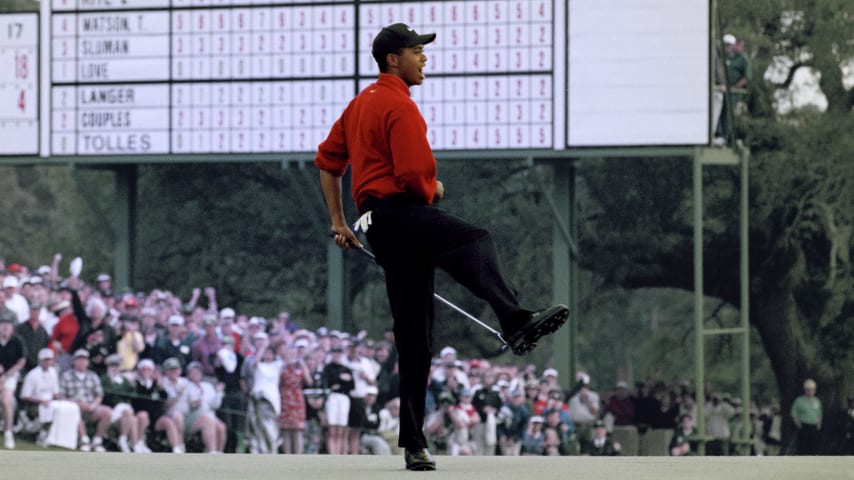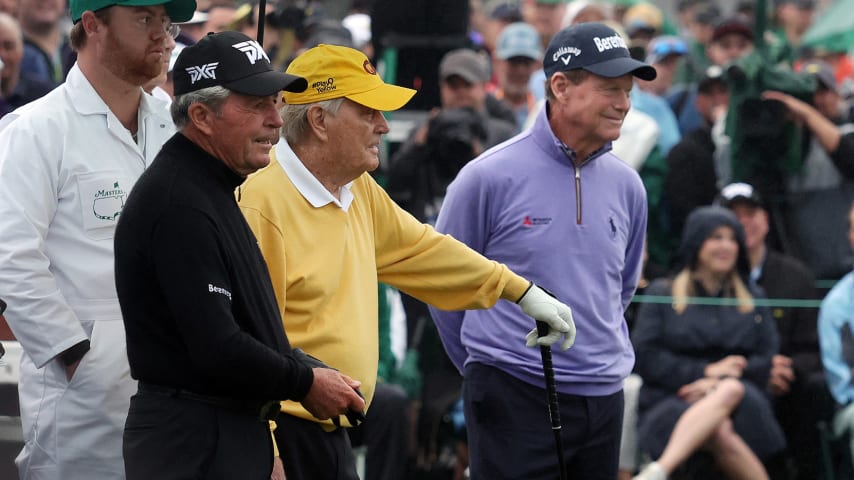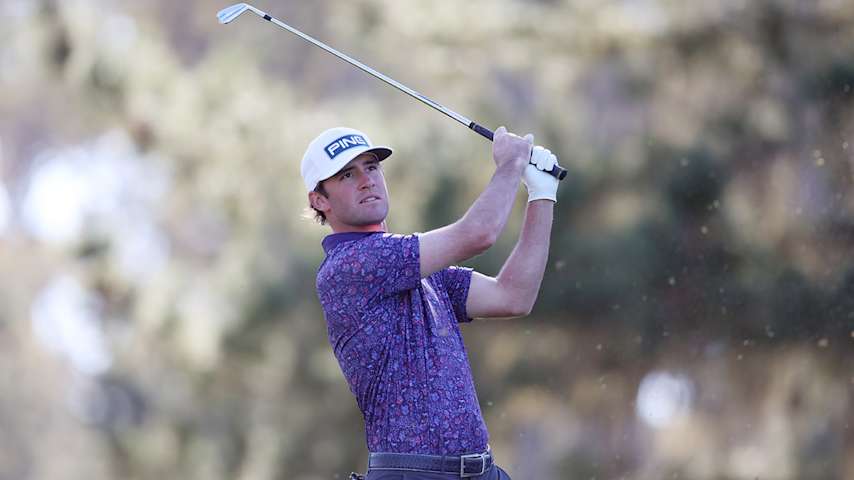Tiger Woods set the doubters straight at the 1997 Masters
10 Min Read

This year marks the 25th anniversary of Woods’ historic 12-shot route
Written by Bob Harig
This year marks the 25th anniversary of Woods’ historic 12-shot route

Tiger Woods' all-time shots on the PGA TOUR
Tiger Woods had already won twice on the PGA TOUR going into 1997, and he did so again at the season-opening Mercedes Championship in La Costa, California, beating the reigning Player of the Year and Open Championship winner, Tom Lehman, in a playoff to win the event now known as the Sentry Tournament of Champions.
There were no more victories leading up to the Masters – at least not official ones.
As if to forecast what was about to occur, Woods shot a course-record 59 while playing with TOUR veteran Mark O’Meara at Isleworth on the Friday prior to heading to Augusta. He shot 32–27 from the back tees, which then played to 7,179 yards and a USGA slope rating of 74.4. Basically, that means the course ranked among the toughest in Florida.
The next day, they played again, with money on the line: $10 automatic 1-downs, meaning any time a player fell behind by a hole, a new $10 bet started from that point until the end of the nine holes. Starting on the 10th hole, Woods birdied to immediately go 1-up, meaning a new $10 bet was triggered. At the 11th hole, a par-3, Woods had the honors and hit first.
“I haven’t even gotten out of my cart, but he hits it and it’s going right at (the flag),” O’Meara recalled. “It one-hops and goes into the hole for a hole in one.”
Before even attempting his own tee shot, O’Meara quit.
“I put $100 on his cart and said, ‘I’ll see you on the range.’” O’Meara chuckled. “You’re 16-under par for 20 holes. I quit. I’m outta here.”
We didn’t know it at the time, but Thursday, April 10, 1997, was the true beginning of what would become the legend known as Tiger Woods. Yes, he’d produced all those amateur exploits. He’d already won three times as a pro. He’d just turned 21 a few months prior. But the opening round of the Masters was also the start of something special.
Per tradition, the defending champion, Nick Faldo, was paired with Woods, the reigning U.S. Amateur champion. The six-time major winner Faldo was coming off a victory at Riviera in Los Angeles. Despite having never played in a major championship as a pro, Woods was installed as an 8–1 cofavorite with Faldo and Greg Norman—the tough-luck loser to Faldo a year prior.
It was not a smooth start, however, for Tiger. He appeared nervous on the first tee and hit an opening drive to prove it, launching it well wide of the fairway and making bogey. He added three more on the first nine, including the par-5 eighth and again at the ninth to take 40 strokes and stand at 4 over through nine holes.
But Woods gathered himself—he said he tried to return to the feelings of a week earlier when shooting 59 at his home course in Florida— and blistered the second nine with four birdies and an eagle. His 6-under-par 30 gave him a round of 70, just three strokes back of first-round leader John Huston (who holed out for an eagle at the 18th, eliciting the Augusta Chronicle headline: “Huston, The Eagle Has Landed”). Faldo shot 75.
“He came in with such major attention,” Faldo said. “And he used it in his favor. No player before walked to the first tee with eight policemen around him. Suddenly Tiger decided he needed security. He had a whole different aura. An aura around him where everybody watched him and listened. And everybody wanted a piece of it. Yes, it was amazing.
“He went out in 40 and back in 30,” Faldo continued, “and then we didn’t see him for the next 14 years. He left us in the dust. It was a special day.”
The azaleas and the dogwoods had no chance. Augusta National was on fire.
Paul Azinger played with Woods on Friday, and Woods shot 66 to take the lead. Azinger was just as impressed as Faldo, and says of Woods today, “He’s less afraid of failure than anybody I’ve ever seen.” Even so, a third highly accomplished pro remained unmoved by the emerging phenomenon that was Woods as players looked forward to the weekend.
Colin Montgomerie had shot 67 to get into the last group on Saturday. He was three strokes back, but Monty was an accomplished veteran in the midst of winning the European Tour’s Order of Merit (money title) seven straight years (through 1999). He’d contended in majors.
“There’s more to it than hitting the ball a long way,” Montgomerie said, anticipating his round with Woods. “And the pressure’s mounting more and more. I’ve got more experience, a lot more experience, in major championships than he has. And hopefully I can prove that.”
Nope. The next day, Woods played a near-flawless third round with seven birdies and no bogeys for a 7-under-par 65 while Montgomerie made three front-nine bogeys on his way to a 74. He dropped 12 shots back into a tie for sixth while Woods led the tournament by nine.
It was a remarkable display from a 21-year-old playing in his first major as a pro. Woods missed a single fairway and just one green — at the par-4 third, where he saved par with a 10-footer.
“I’m probably the reason he did what he did,” Montgomerie said years later. “I played with Tiger on that famous day on the Saturday. I witnessed something very special that day. I thought I would beat him. I was wrong. And everyone else was wrong as well. But I admitted it.
“I’d just witnessed something very special,” Montgomerie continued. “I thought I shot a very solid 74 until I lost to him by nine shots. I witnessed something that nobody else had seen.”
The Scotsman surprised the writers in Augusta National’s media center early Saturday evening by showing up to talk. Nobody requested him; nobody in their right minds ever thought he would want to talk after the beatdown that had just occurred. But not only did Monty take a seat in front of the scribblers, he also wowed them with his praise of Woods.
If there was any doubt about the outcome the next day, with Woods leading Costantino Rocca by nine strokes, Montgomerie did his best to dispel it. “We’re all human beings here,” he said. “But there is no chance humanly possible that Tiger Woods is going to lose this tournament.”
Reminded that Norman lost a six-shot lead a year earlier, Montgomerie said, “This is different; this is very different. Faldo’s not lying second, for starts. And Greg Norman’s not Tiger Woods.”
Woods put to rest any doubts about squandering the lead with two birdies and two bogeys over the first nine. Rocca never got closer than eight strokes. At that point, all that was left was the 72-hole scoring record, which Woods set by shooting 3 under on the second nine—and converting a tricky par putt at the 18th—to finish 12 strokes ahead of Tom Kite.
It was a coronation amid the towering pines. Woods, a man of color, took his place among the game’s greats at an event that did not invite its first Black player until the year he was born.
That man, Lee Elder, was at Augusta. He had flown from Florida to Atlanta that morning and was driving—too fast—to Augusta when he saw the red flashing lights in his rearview mirror. As the officer, who Elder noted was also Black, began writing out a ticket, Elder made his case.
“I gave him the whole story,” Elder said. “‘There’s history about to be made in your state. Tiger Woods is about to win the Masters. I’m just trying to get there before he tees off.’
“He just kept writing and writing,” Elder continued. “When he got through, he gave me the ticket and said I either had to sign it or follow him to the precinct.”
And then there was the final kicker.
“He told me, ‘I don’t know who Tiger Woods is, and I don’t like golf,’” Elder said.
Few would not know the name Tiger Woods again after this day. Black workers at the club snuck a peek at him on the first tee and stood on the balcony of the old manor clubhouse, cheering him as he putted out on the 18th while his record-setting performance was witnessed, in part, by some 44 million television viewers during the final round.
Those who played with him could only wonder. At the time, they weren’t contemplating the social ramifications of his play; they were simply marveling at what was on display.
Woods set the tournament scoring mark of 270, 18 under par, and became the youngest player to win the title. His 12-shot victory was the largest in any major championship going back to the 1862 Open at Prestwick. There, Tom Morris Sr. won by 13 shots—in a field that saw just eight players and on a 12-hole layout that was played three times—at a time when Abraham Lincoln was the U.S. president and golf had yet to be established in the United States.
Woods later set a new standard when he won the 2000 U.S. Open at Pebble Beach by 15 strokes.
“It’s always a pleasure to speak about him,” Rocca said from his home in Italy years later. “He has done so much for golf. It wasn’t surprising. I had played with him when he was an amateur at the U.S. Open (the year prior at Oakland Hills). I saw the potential he had.”
After his victory, Woods greeted Earl and Tida behind the 18th green. The hug with his dad aired a million or more times over the years and played repeatedly for comparison when Woods won the Masters for the fifth time in 2019 and hugged his son, Charlie, behind the same 18th green.
Before he could get comfortable in his first green jacket, Woods took a call from President Bill Clinton, and later described it as if it were a chat with one of his buddies.
“He just said he was proud of the way I played,” Woods said. “He also said, what meant a lot, the best shot he saw all week was the shot of me hugging my dad.”
Phil Mickelson was long gone, having missed the cut. (Mickelson didn’t miss another Masters cut until 2014.) Jim “Bones” Mackay, his then-caddie, watched the Woods coronation on TV.
“I couldn’t believe a kid his age could consistently back off shots because of wind changes and be as composed,” Mackay said. “His golf I.Q. was incredible. I remember thinking, look at this guy; he’s backing off shots; he’s waiting on his wind, which is the key to playing well at Augusta, in my opinion. We all knew about the swing and the putting stroke. But at that point, I’m realizing how smart he is on the course and how composed. That kind of blew me away.”
All in the game felt the same way. Even though the final round was a foregone conclusion well before Woods even got to the course, it was riveting. Nobody could take their eyes off the proceedings. And it sparked even more interest in Woods and what he would do next.
Nobody knew what was coming, but they certainly would be glued to their televisions, as golf ratings soared whenever Woods played. A commitment to a tournament meant sent organizers scrambling to add concession facilities, parking places, grandstands, hospitality options, and security. It was wild. And it virtually never subsided, no matter when and where Woods played.






